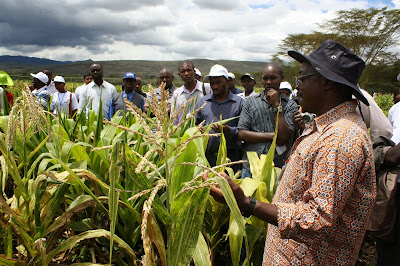Addressing food insecurity in Kenya
through seed quality assurance
Njenga Hakeenah
November 15 2013
Since the discovery of the Maize
Lethal Necrosis Disease MLND in Kenya in the year 2011, efforts to manage it
have been in high gear.
This is to ensure that the country
does not suffer food insecurity where maize is the staple food.
The Constitution of Kenya declares
access to food as one of the basic Human Rights thus underscoring the
importance of seeds and agricultural productivity.
Agriculture, livestock and fisheries
Cabinet secretary Felix Koskei says globalisation and creation of trade and
marketing blocks has expanded the market. Due to this, he says, Kenya envisions
becoming “a globally competitive, prosperous country with a high quality of
life for all its citizens” by the year 2030, as spelt out in the latest
development blueprint: The Kenya Vision 2030.
He adds, “This should serve to
encourage collaborators and the private sector to participate in the
agricultural industry. This can be attested by the harmonization of seed
policies, laws and regulations that have been going on in the EAC, ASARECA, and
COMESA which are now in the implementation stage.”
Koskei says this will greatly
influence the faster and efficient movement of seed in the region, hence access
by the farmer challenging the Seed industry to take up the challenge and
satisfy the market needs.
The Kenya Government has
established-with funds from the Syngenta and the Bill and Melinda Gates Foundations
established the Naivasha Maize Lethal Necrosis Screening facility.
The International Maize and Wheat
Improvement Center CIMMYT's Dr George Mahuku says MLND affects seed production which
in turn affects food security.
 |
| Dr. George Mahuku explains the MLND to seed trade stakeholders at the Marula Farm Test Site in Naivasha Photo: Njenga Hakeenah |
“If seed quality is compromised, all
other inputs will not help much as the source of crop life is not completely
viable to give quality life”, adds Dr. Mahuku. This in turn he says,
compromises productivity affecting yields as well as probably contaminating
future crops if the seeds are harvested and used later.
In a country where biotechnology is frowned upon and treated
with scepticism, Dr. Mahuku opines that it could be the solution to managing MNLD as genetics could play a key role towards this
end. He also advocates crop rotation and using
clean seeds.
Kenya’s reliance on maize has threatened other food crops-mostly
referred to as orphan crops- making it hard to address food insecurity.
Dr James Nyoro, an agronomist says of
the overreliance on maize, “When there's no maize, Kenyans say there's no food
even when there's a lot of yam.” Nyoro adds Kenyans need to move away from this
mentality and adopt other crops for food if they are to avoid the perennial
food shortages and in many cases droughts.
Orphan crops like sorghum, millet and
others have for long been sidelined from meal tables which gave maize an edge
but risking the country’s food security.
“The country needs to diversify if it
is to comfortably feed the burgeoning population. Otherwise if we stick with
the same old policies and structures, this will remain a dream for a country
aiming to be a middle income country by 2030.” Nyoro quips.
The adoption of several food crop
varieties would give Kenya an advantage in feeding the burgeoning population. The
government is in the meantime mulling a two child per family policy in a bid to
slow down population growth.
With this growth and speaking at a
time when the country has experienced huge losses occasioned by the MLN
disease, Dr. Nyoro opines that policies should also be put in place and
implemented especially surrounding seeds whose quality determines the harvest
outcomes.
He opines that Kenya's seed industry
is dominated by one company and which is a threat to food security. He adds that the company had access to publicly developed materials and
continually receives subsidies from government so it can offer seed prices at
subsidized levels. However this lack of a level playing field has occasioned high
costs but low quality seeds risking food insecurity.
 |
| The newly commissioned Maize Lethal Necrosis Screening facility in Naivasha Photo: Njenga Hakeenah |
Kenya’s vision 2030 is heavily
premised on the success of ICT and agriculture which remains the single biggest
employer at 24% of the GDP.
Syngenta East Africa’s MD Walter
Njenga says food demand is on an increase and it’s challenged by low
productivity. He says technology can play a major role in ensuring that Kenya
becomes food sufficient. This is echoed by the Kenya seed Trade Association of
Kenya STAK’s Chair Azariah Soi who intimates that adopting innovative
technologies will increase agricultural productivity placing Kenya in an
advantage position to deal with food insecurity.
Storify link: http://storify.com/Hakeenah/stakcongress
The issue of biotechnology and
especially around genetically modified organisms GMO remains shrouded in
mystery in Kenya. Those against GMOs fear that the foods will be a threat to
health and also to indigenous farming. Those who are pro-GMO say that the fears
are unfounded and this means will keep experiencing the perennial food
shortages. They say that biotechnology should be used to augment agricultural
output.
Wanjiru Kamau from the Kenya Organic Agricultural Network says
it is better to continue with conventional and
traditional farming rather than introduce a technology which may
prove fatal in the future.
As an organic
farmer she feels investing in GMOs would be a risk and a gamble with the future
food security issues.
And as this tug of war between those
pro and con Biotechnology continues, the country is losing billions invested in
research as well as unnecessary deaths due to lack of food.
If this continues, then it means that
the country's ambition of attaining food security and the Blueprint Vision 2030
remains a mirage.








